Set out on a culinary journey to unravel the mysteries of Moroccan cuisine, a tantalizing fusion of flavors and traditions. From the bustling markets of Marrakech to the serene Atlas Mountains, Morocco’s culinary landscape offers a tapestry of tastes waiting to be uncovered. With each bite of succulent Tagine or fluffy Couscous, one can taste the history and heritage woven into every dish. Join in as we peel back the layers of this vibrant cuisine, where spices whisper tales of distant lands and recipes hold the key to unlocking the secrets of Morocco’s gastronomic treasures.
Good To Know
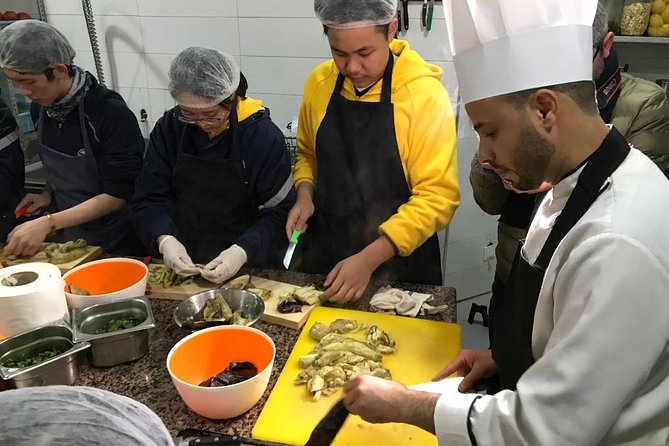
- Moroccan cuisine rooted in rich tradition and diverse ingredients.
- Signature dishes like Tagines and Couscous showcase bold flavors.
- Essential spices like cumin, cinnamon, and saffron define Moroccan dishes.
- Cooking techniques like Tagine and grilling add unique flavors.
- Culinary heritage reflects Berber, Arab, and French influences.
Moroccan Culinary Heritage

With a rich and diverse culinary heritage deeply rooted in tradition and local ingredients, Moroccan cuisine offers a delightful journey for the taste buds. Influenced by a mix of Berber, Arab, and French cooking styles, Moroccan dishes are known for their bold flavors and aromatic spices.
Tagines, a staple in Moroccan cooking, are slow-cooked stews that combine meat, vegetables, and fruits, creating a harmonious blend of sweet and savory. Couscous, another Moroccan favorite, is a fine semolina pasta often steamed and served with a variety of toppings like vegetables, meat, or fish.
The generous use of ingredients such as saffron, cinnamon, cumin, and preserved lemons gives Moroccan cuisine its unique and exotic taste that captivates foodies worldwide.
Enjoying the local flavors? More Fez food experiences we've written about
Traditional Moroccan Ingredients

Exploring the vibrant tapestry of Moroccan cuisine unveils a treasure trove of traditional ingredients that form the heart and soul of the country’s flavorful dishes. These ingredients, sourced from the land and sea, are meticulously combined to create dishes that are a true reflection of Moroccan culture and history:
Spices: Moroccan cuisine is renowned for its bold and aromatic spices like cumin, cinnamon, paprika, and saffron.
Olives: With a variety of olive trees growing across the country, olives and olive oil are staples in many Moroccan recipes.
Couscous: This tiny steamed semolina grain is a ubiquitous ingredient in Moroccan cuisine, often paired with vegetables, meats, or stews.
Preserved Lemons: A key ingredient in many tagines, preserved lemons add a unique tangy flavor to dishes, enhancing their complexity.
Popular Moroccan Dishes
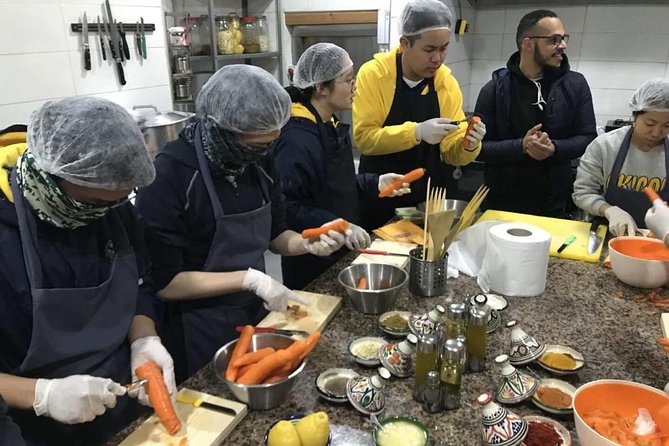
Moroccan cuisine captivates with a rich tapestry of popular dishes that showcase the country’s culinary prowess and cultural heritage. Here are some beloved Moroccan dishes:
| Dish | Description | Key Ingredients |
|---|---|---|
| Tagine | A flavorful stew cooked in a cone-shaped pot | Meat, vegetables, spices |
| Couscous | Steamed semolina grains served with vegetables | Semolina, vegetables, spices |
| Pastilla | A sweet and savory pie with a delicate crust | Pigeon, almonds, cinnamon |
These dishes reflect the diverse flavors and textures that Moroccan cuisine is known for. From the tender Tagine to the fragrant Couscous, each bite tells a story of tradition and innovation in Moroccan cooking.
Spices and Flavors of Morocco
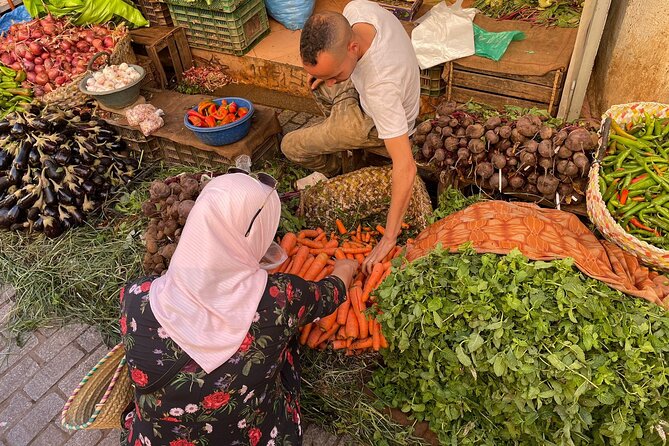
The vibrant tapestry of flavors and aromas that characterize Moroccan cuisine is a sensory journey through a rich heritage of spices and culinary traditions.
When exploring the spices and flavors of Morocco, one can expect:
Ras el Hanout: A complex blend of up to 30 spices, including cumin, cinnamon, and turmeric, adding depth to dishes.
Cinnamon and Ginger: Commonly used together, creating a warm and slightly sweet undertone in savory and sweet dishes.
Saffron: Known as the world’s most expensive spice, it imparts a distinct golden color and delicate flavor to Moroccan dishes.
Harissa: A fiery chili paste that adds a spicy kick to many dishes, balancing flavors with its heat.
These essential ingredients combine to create the unique and unforgettable taste of Moroccan cuisine.
Cooking Techniques in Morocco
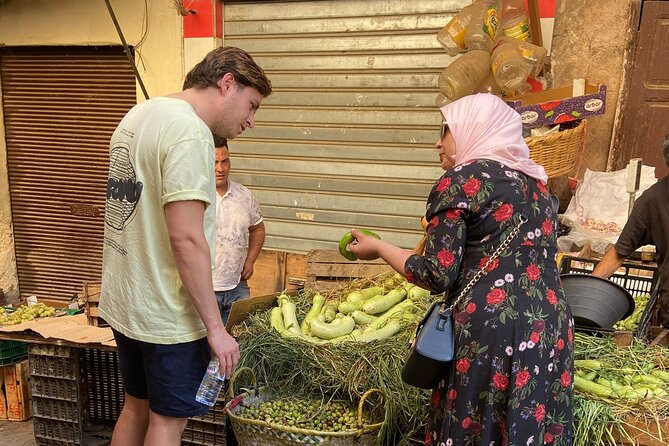
In Moroccan cuisine, traditional cooking techniques play a vital role in creating the diverse and flavorful dishes that define this culinary culture. One of the most common methods is slow cooking in a clay pot called a tagine, which allows the ingredients to meld together while preserving their individual flavors. Grilling over charcoal is also popular, imparting a smoky taste to meats and vegetables. Another prevalent technique is steaming, often used for couscous, a staple of Moroccan meals. The following table provides a glimpse into some traditional cooking techniques found in Moroccan cuisine:
| Cooking Technique | Description | Example Dish |
|---|---|---|
| Tagine Cooking | Slow cooking in a clay pot | Chicken Tagine |
| Grilling | Cooking over charcoal | Lamb Kebabs |
| Steaming | Using steam to cook ingredients | Vegetable Couscous |
More tours and activities we've covered in Fez
Dining Customs and Etiquette

Exploring Moroccan dining customs and etiquette offers a fascinating insight into the cultural significance of sharing meals in this vibrant culinary tradition. Here are some key points to keep in mind when dining in Morocco:
Handwashing:
It’s customary to wash your hands before and after the meal, often using a communal basin.Seating Arrangement:
Guests are typically welcomed and seated according to hierarchy or age, with the host showing great hospitality.Eating with Hands:
Using your right hand for eating, especially when enjoying traditional dishes like couscous or tagine, is common.Saying Thanks:
It’s polite to express gratitude to the host and say ‘Bismillah’ (in the name of God) before starting the meal.
Moroccan Food and Culture
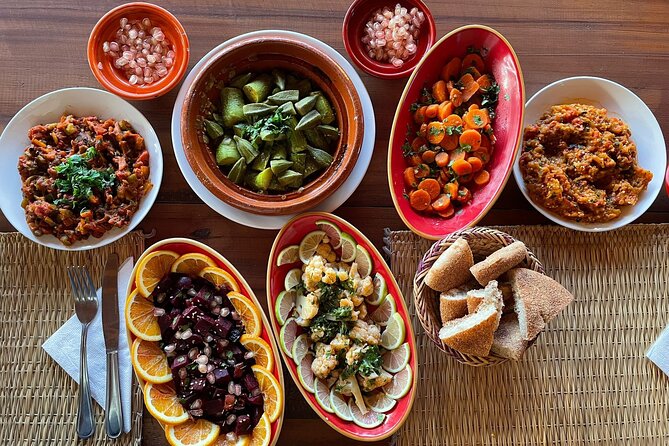
Delving into the culinary tapestry of Morocco unveils a rich fusion of flavors and traditions that reflect the essence of Moroccan culture. Moroccan cuisine isn’t just about the food; it’s a celebration of community, hospitality, and togetherness.
Meals often bring families and friends together, emphasizing the importance of sharing and socializing. The intricate blend of spices like cumin, cinnamon, and saffron in dishes such as tagines and couscous mirrors the country’s diverse history and influences.
Plus, the traditional way of serving mint tea symbolizes friendship and respect. Food plays a central role in Moroccan festivals and gatherings, highlighting the deep connection between Moroccan food and the country’s vibrant cultural tapestry.
Exploring Moroccan Street Food
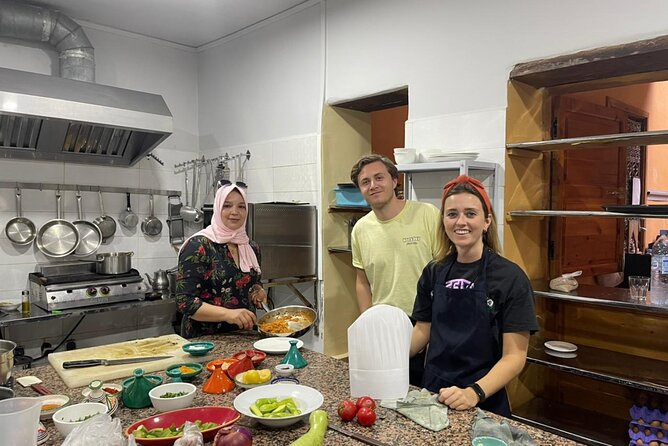
Discover the vibrant and flavorful world of Moroccan street food as you navigate the bustling markets and alleys of Fez, Morocco.
Harira Soup: A hearty tomato-based soup with lentils, chickpeas, and fragrant spices like cumin and coriander.
Kefta Tagine: Savory spiced meatballs cooked in a flavorful tomato sauce, served with crusty bread for dipping.
Msemen: A delicious square-shaped flatbread, typically stuffed with cheese, honey, or a savory filling like spiced meat.
Moroccan Mint Tea: A refreshing and aromatic drink made with green tea, fresh mint leaves, and sugar, a perfect way to end your street food adventure.
Enjoy the lively street food scene of Fez, where the aromas and flavors will tantalize your taste buds and leave you craving more.
Frequently Asked Questions
Can I Request Special Dietary Accommodations for the Moroccan Cooking Class?
Yes, travelers can request special dietary accommodations for the Moroccan cooking class. The experience includes lunch, coffee and/or tea, and bottled water. Pickup is available at any desired hotel in Fez. It is also wheelchair and stroller accessible.
Are Cooking Classes Suitable for Beginners With No Prior Experience?
Cooking classes are suitable for beginners with no prior experience. Participants can enjoy hands-on learning in a friendly environment. Skilled instructors guide each step, ensuring a fun and educational experience for all.
Is There an Age Restriction for Participating in the Cooking Classes?
There is no age restriction for participating in the cooking classes. People of all ages are welcome to join and learn the secrets of Moroccan cuisine. The classes cater to beginners and those with no prior experience.
Can I Take Home the Recipes of the Dishes We Prepare in the Class?
Yes, participants in the cooking class can take home the recipes of the dishes they prepare. The experience includes the opportunity to learn and recreate the flavorful Moroccan cuisine at home, ensuring a lasting taste of the culture.
Are There Any Souvenirs or Local Products Available for Purchase After the Class?
Yes, there are souvenirs and local products available for purchase after the class. Visitors can find unique items like spices, traditional cookware, and artisanal crafts to take home as reminders of their Moroccan culinary experience.
The Sum Up
To sum it up, the secrets of Moroccan food reveal a rich tapestry of flavors, traditions, and history. From the aromatic spices to the unique cooking techniques, each dish tells a story of Morocco’s culinary heritage.
By exploring the diverse ingredients and bold flavors, one can truly experience the essence of Moroccan gastronomy.
So next time you sit down to enjoy a Tagine or savor a plate of Couscous, remember the cultural significance and delicious flavors that make Moroccan cuisine truly special.
More Food Tours in Fez
More Food & Drink Tours in Fez
More Tour Reviews in Fez
Looking for something different? Other Fez activities we've written about
- 13 Best Shopping Tours In Fez
- 25 Best Workshops And Classes In Fez
- 20 Best Historical Tours In Fez
- 20 Best 3 Day Tours In Fez
- 25 Best Tours In Fez
- 20 Best 2 Day Tours In Fez
- 20 Best Airport Transfers In Fez
- 20 Best 4 Day Tours In Fez
- 20 Best Private Driver Services In Fez
- 20 Best Full-Day Tours In Fez
- 4 Best 3 Hour Tours and Experiences in Fez
- 25 Best Guided Tours In Fez
